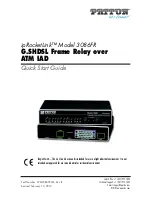
31. Dynamic Routing
ROX™ v2.2 User Guide
330
RuggedBackbone™ RX5000
31. Dynamic Routing
31.1. Introduction
This chapter familiarizes the user with:
• Enabling the Dynamic Routing Suite
• Enabling and starting OSPF, RIP, and BGP
• Configuring OSPF, RIP, and BGP
• Obtaining OSPF, RIP, and BGP Status
• OSPF and VRRP
31.1.1. RIP, OSPF, and BGP
Dynamic routing is provided by a set of routing protocol daemons. The following daemons manage
routing: core, ripd, ospfd, and bgpd.
The core daemon handles interfacing with the kernel to maintain the router’s routing table and to check
link statuses. It tells RIP, OSPF, and BGP what state links are in, what routes are in the routing table,
and some information about the interfaces.
The ripd, ospfd, and bgpd daemons handle communications with other routers using the RIPv2,
OSPFv2, and BGP protocols respectively, and decide which routers are preferred to forward to for each
network route known to the router.
In complex legacy networks, RIP, OSPF, and BGP may be active on the same router at the same time.
Typically, however, one of them is employed.
31.1.2. RIP Fundamentals
The Routing Information Protocol determines the best path for routing IP traffic over a TCP/IP network
based on the number of hops between any two routers. It uses the shortest route available to a given
network as the route to use for sending packets to that network.
The ROX™ RIP daemon (ripd) is an RFC1058 compliant implementation of RIP support RIP version 1
and 2. RIP version 1 is limited to obsolete class based networks, while RIP version 2 supports subnet
masks as well as simple authentication for controlling which routers to accept route exchanges with.
RIP uses network and neighbor entries to control which routers it will exchange routes with. A network
is either a subnet or a physical (broadcast-capable) network interface. Any router that is part of that
subnet or connected to that interface may exchange routes. A neighbor is a specific router to exchange
routes with specified by its IP address. For point to point links (T1/E1 links for example) one must use
neighbor entries to add other routers to exchange routes with. The maximum number of hops between
two points on a RIP network is 15, placing a limit on network size.
Link failures will eventually be noticed although it is not unusual for RIP to take many minutes for a dead
route to disappear from the whole network. Large RIP networks could take over an hour to converge
when link or route changes occur. For fast convergence and recovery, OSPF is a much better choice.
RIP is a fairly old routing protocol and has mostly been superseded by OSPF.
31.1.3. OSPF Fundamentals
The Open Path Shortest First (OSPF) protocol routing determines the best path for routing IP traffic
over a TCP/IP network based on link cost and quality. Unlike static routing, OSPF takes link failures
and other network topology changes into account. Unlike the RIP routing protocol, OSPF provides less
router to router update traffic.
















































